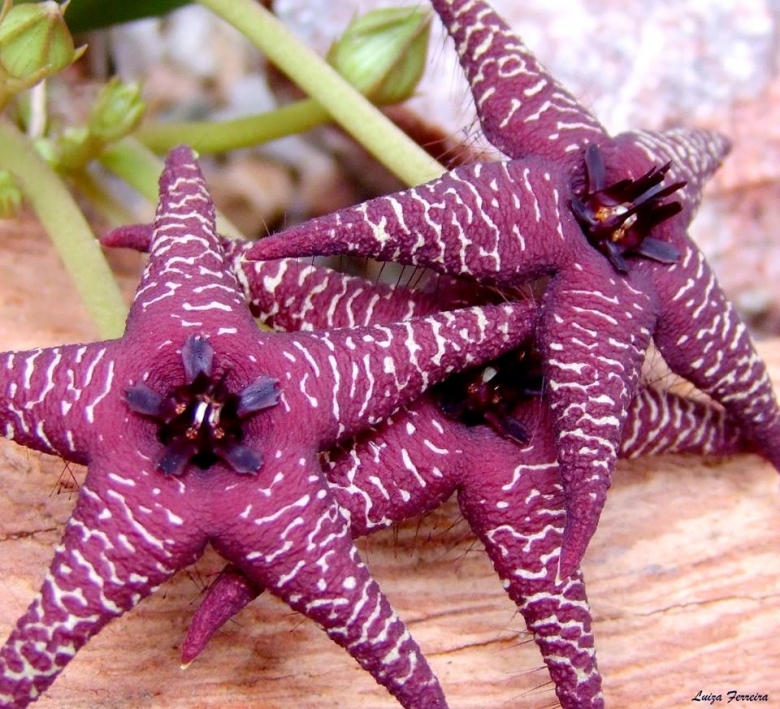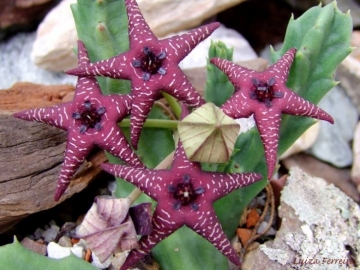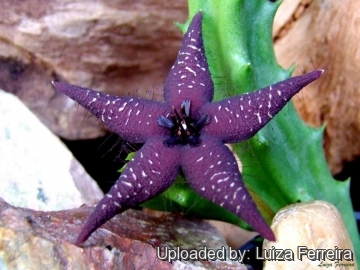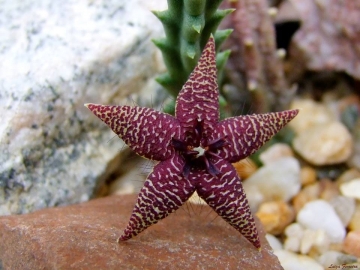
Orbea cv. Starlight Photo by: Luiza Ferreira
Origin and Habitat: Garden origin, hybrid.
Synonyms:
Common Names include:
ENGLISH: Starlight orbea
Description: Orbea cv. StarlightSN|30532]]SN|30622]] is homemade hybrid involving Orbea verrucosaSN|30622]]SN|30532]] as one of the parents. It is known by its very handsome and highly curious star-shaped flowers purple-violet in colour with transverse creamy white lines. The plants are large and robust and forms lax clumps, that sometimes spread for up to 50 or more cm with stems arising from a short horizontal base. Several clones are available: the more common ones are purple-violet with more or less conspicuous transverse creamy white lines, while the other are almost entirely purple-violet with only a few creamy-white blotches or broken lines.
 Orbea cv. Starlight Photo by: Luiza Ferreira
Orbea cv. Starlight Photo by: Luiza Ferreira Orbea cv. Starlight Photo by: Luiza Ferreira
Orbea cv. Starlight Photo by: Luiza Ferreira Orbea cv. Starlight Photo by: Luiza Ferreira
Orbea cv. Starlight Photo by: Luiza Ferreira Orbea cv. Starlight Photo by: Luiza Ferreira
Orbea cv. Starlight Photo by: Luiza Ferreira Orbea cv. Starlight Photo by: Luiza Ferreira
Orbea cv. Starlight Photo by: Luiza FerreiraSend a photo of this plant.The gallery now contains thousands of pictures, however it is possible to do even more. We are, of course, seeking photos of species not yet shown in the gallery but not only that, we are also looking for better pictures than those already present.
Read More... Cultivation and Propagation: Orbea cv. StarlightSN|30622]]SN|30622]] grow well in light gritty soil with a very liberal drainage. They should at all times sparingly watered (best rain water with some occasional fertiliser), and in winter time they hardly require any. They require outdoor culture, or a warm close greenhouse, while growing in the early part of summer, and afterwards may be ripened and kept in a greenhouse; but as they bloom chiefly in autumn, warmth is desirable to enable them to expand their flowers.
A minimum winter temperature of 5-10°C is acceptable, providing that plants are kept absolutely dry. They prefer light shade rather than full sun, although stems may not colour up under shady conditions.
Propagation: Plants are usually increased by cuttings, which, as they are very succulent, should be allowed to dry a week after they are taken off, when they may at once be put singly into pots.
Pest & diseases: Keep their roots free of mealy bugs, as fungal attack often occurs as a result of damage to stems by insects. A layer of grit on the surface of the compost prevents moisture from accumulating around the base of the stems and minimise the chance of fungal attack on the roots.















